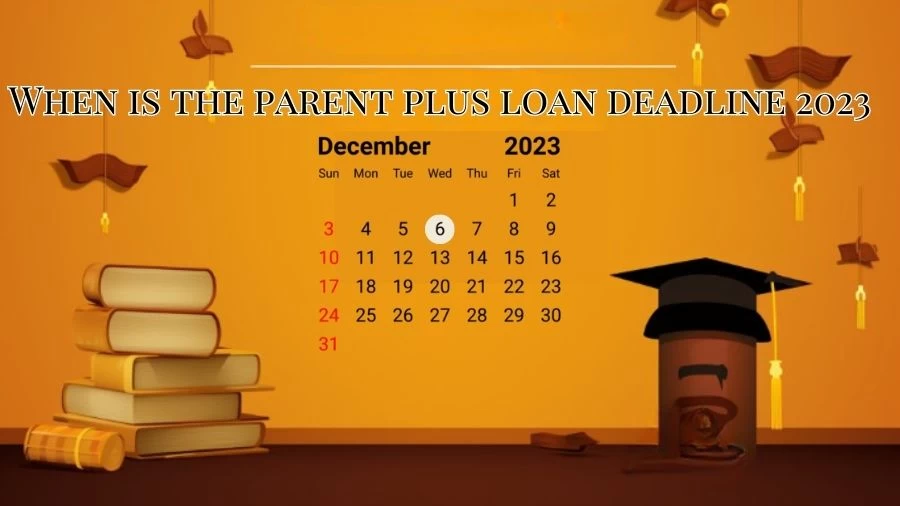
When is the Parent Plus Loan Deadline 2023? How Long is the Grace Period for Plus Loans?
Parent PLUS Loan application deadlines for 2023 are December 6th for Fall and May 1st, 2024 for Spring, with no grace period; post-graduation, a six-month deferment provides payment flexibility, requiring active loan service engagement.
by Sangamithra
Updated Aug 19, 2023
On This Page
- When is the Parent PLUS Loan Deadline 2023?
- How Long is the Grace Period for PLUS Loans?
- What is Parent PLUS Loan?
- Do Parent PLUS Loans Qualify for PSLF?
- How Do Parent PLUS Loans Work?
- Parent PLUS Loan Interest Rate
- Parent PLUS Loan Maximum Amount
- Parent PLUS Loan Eligibility
- How Do I Apply for a Parent PLUS Loan?
- Parent PLUS Loan FAFSA
- What is the Loan Period for Parent PLUS?
When is the Parent PLUS Loan Deadline 2023?
The application deadlines for the parent PLUS loan in 2023 align with the specified loan periods. For the Fall 2023 term, spanning from August 2023 to December 2023, the deadline to apply for the loan is set for December 6, 2023.
Similarly, for the Spring 2024 term, encompassing January 2024 to May 2024, the application deadline for the loan is May 1, 2024. It's essential to adhere to these deadlines to ensure timely consideration and processing of the parent PLUS loan applications for the respective requested loan periods in 2023.
How Long is the Grace Period for PLUS Loans?
Grace periods are not applicable to PLUS loans. However, if you obtained a PLUS loan as a graduate or professional student, an automatic six-month deferment comes into effect upon your graduation, departure from school, or transition to less than half-time enrollment status.
During this six-month deferment, no obligation exists for making loan payments. This deferment affords you a temporary financial reprieve, allowing you to manage your post-education transition without immediate repayment burdens. It's crucial to be aware of this arrangement and the timeline it encompasses.
Utilize this deferment period wisely to adjust to your new circumstances before the commencement of the loan repayment phase. Remember that the specifics of deferment can differ, so it's advisable to stay informed and engage with loan servicing agencies to navigate your loan journey effectively.
What is Parent PLUS Loan?
Parent PLUS loans are educational loans provided by the U.S. Department of Education. These loans feature standardized interest rates and charges applicable to all eligible recipients. They empower parents to borrow up to the total cost of attendance for their child, as determined by the educational institution.
Facilitated by the federal government, these loans cater to parents of dependent students, furnishing financial support for their higher education journey. (It's important to note that grandparents and legal guardians are ineligible for Parent PLUS Loans unless they have formally adopted the student.)
The interest rate for Parent PLUS Loans, allocated to loans disbursed between July 1, 2022, and July 1, 2023, presently stands at 7.54%. This rate remains constant for the entire loan duration.
Furthermore, an accompanying fee of 4.228% is applicable to loans distributed between October 1, 2022, and October 1, 2023. The structured nature of Parent PLUS loans ensures a comprehensive means for parents to financially contribute to their child's educational pursuits.
Do Parent PLUS Loans Qualify for PSLF?
The situation is a bit intricate. Parent PLUS loans aren't inherently eligible for income-driven repayment plans, which are crucial for obtaining debt forgiveness after 120 qualifying payments. Nonetheless, if these loans have entered repayment after July 1, 2006, and are encompassed in a Federal Direct Consolidation Loan, they might become eligible for Income-Contingent Repayment (ICR), the oldest income-driven repayment scheme.
It's important to note that a Federal Direct Consolidation Loan used to repay a Parent PLUS loan doesn't typically qualify for other income-driven repayment plans. In essence, this presents a pathway for Parent PLUS loan forgiveness through PSLF by consolidating the loans and opting for an income-contingent repayment plan.
The key requirements include making 120 qualifying payments while the loans are under the Direct Loan program, within a qualifying repayment plan (which could be income-driven or standard), and while the borrower is engaged full-time in a qualifying public service role.
It's worth mentioning that the Temporary PSLF Waiver, effective until October 31, 2022, doesn't extend to Parent PLUS loans. Additionally, volunteer work is usually not considered, except in specific programs like AmeriCorps and the Peace Corps.
How Do Parent PLUS Loans Work?
Certainly, here's a step-by-step process outlining how parent PLUS loans work:
Complete the FAFSA: Your child must first complete the Free Application for Federal Student Aid (FAFSA) to determine their eligibility for financial aid, including federal loans.
Determine Eligibility: As a parent, you must meet the eligibility requirements for a parent PLUS loan. These include being the biological or adoptive parent of a dependent undergraduate student enrolled at least half-time in an eligible school.
Apply for the Loan: After your child completes the FAFSA, you can apply for a parent PLUS loan using a separate application process provided by the Department of Education. This application will involve providing personal and financial information.
Credit Check: The Department of Education will perform a credit check as part of the application process to determine your creditworthiness. Adverse credit history might affect your eligibility, but you can consider getting a co-signer if necessary.
Loan Approval: If your application is approved, you'll be notified about the loan amount you're eligible for.
Loan Disbursement: Once approved, the Department of Education will disburse the loan funds directly to your child's school. The school will use these funds to cover various educational expenses, including tuition, fees, and room and board.
Excess Funds: If there are funds left over after covering direct educational costs, the school will disburse the remaining funds to your child. These excess funds can be used for other eligible education-related expenses, such as textbooks, supplies, and transportation.
Repayment: Repayment for parent PLUS loans typically starts after the loan funds have been fully disbursed. However, you might be able to request a deferment while your child is enrolled at least half-time, and for an additional six months after they graduate or drop below half-time enrollment.
Loan Servicer: The Department of Education assigns a loan servicer to manage the repayment process. You'll work with the loan servicer to make monthly payments, choose a repayment plan, and address any concerns you might have.
Repayment Options: You can choose from various repayment plans, including standard, graduated, income-contingent, and income-based plans. Selecting the right plan depends on your financial situation and preferences.
Loan Forgiveness: While parent PLUS loans are not directly eligible for Public Service Loan Forgiveness (PSLF), under certain circumstances, they might become eligible if consolidated into a Direct Consolidation Loan and repaid through an income-contingent repayment plan while working in a qualifying public service job.
Communication: Stay in touch with the loan servicer, keep track of payment due dates, and consider setting up automatic payments to ensure timely repayments.
By following these steps and staying informed about your options, you can effectively navigate the process of obtaining and repaying parent PLUS loans to support your child's education.
Parent PLUS Loan Interest Rate
For Parent PLUS Loans that were initially disbursed between July 1, 2022, and July 1, 2023, the existing interest rate stands at 7.54%. This interest rate remains consistent and doesn't change throughout the duration of the loan repayment. Additionally, for loans that were disbursed between October 1, 2022, and October 1, 2023, an accompanying fee of 4.228% applies.
It's worth noting that this fee is factored in when the loan amount is determined and affects the total amount that you will receive after the fee deduction. This information underscores the importance of considering both the fixed interest rate and the associated fee when assessing the costs and financial implications of Parent PLUS Loans disbursed during the specified time frame.
Parent PLUS Loan Maximum Amount
In contrast to various categories of federal student loans, Parent PLUS Loans offer a notably expansive borrowing capacity. These loans provide the flexibility to borrow up to the total cost of attendance, with the exception of any other financial aid already secured.
This means that the amount you can borrow through Parent PLUS Loans is determined by the overall expenses associated with your child's education, including tuition, fees, accommodation, and other related costs. However, it's crucial to consider any other forms of financial aid your child might have acquired, as these will be subtracted from the total cost of attendance before calculating the maximum loan amount.
This unique feature of Parent PLUS Loans allows parents or guardians to address educational expenses comprehensively, ensuring that the financial needs of their children's education are met.
Parent PLUS Loan Eligibility
Eligibility criteria for Parent PLUS Loans encompass specific conditions for both parents and students. For parents, qualification necessitates being the biological or adoptive parent of an undergraduate student classified as dependent, enrolled at least half-time. U.S. citizenship or eligibility as a non-citizen is mandatory. Meeting credit standards is generally expected, while the student must fulfill the basic eligibility prerequisites for financial aid.
Grandparents and legal guardians, barring legal adoption of the student, are excluded from loan eligibility. For students, eligibility requires U.S. citizenship or eligibility as a non-citizen. Prior student loan defaults are unresolved or not consolidated into a federal direct loan rendering them ineligible.
Male citizens aged 18 to 25 must register with the Selective Service System. These criteria ensure that both parents and students meet the necessary qualifications for securing Parent PLUS Loans.
How Do I Apply for a Parent PLUS Loan?
When completing the application for a parent PLUS loan, the parent assumes responsibility for repayment, not the student. This loan type can be sought through the Department of Education, and the application process involves several steps:
- Confirm eligibility for a parent PLUS loan, meeting criteria like being a parent of a dependent child enrolled in a qualifying school.
- Have your child complete the FAFSA form, which guides the Direct PLUS Loan application process.
- Calculate the desired loan amount by subtracting financial aid from total attendance costs.
- Apply online through the Department of Education's website, sharing necessary information with your child's school.
- Sign the Master Promissory Note, agreeing to loan terms.
- Learn repayment options and consider refinancing through private student loans if needed.
It's crucial to understand eligibility, application, and repayment aspects before proceeding with a parent PLUS loan.
Parent PLUS Loan FAFSA
Parent PLUS loans are government-provided student loans designated for parents. These loans are not confined by borrowing limits, offering more flexibility. To secure a Parent PLUS loan, the initial step involves completing the Free Application for Federal Student Aid (FAFSA) by you or your child.
Afterward, communication with the educational institution is crucial to follow their specific procedures. Generally, many schools require applicants to initiate the Parent PLUS loan application through
It's important to highlight that the key distinction with the Parent PLUS loan is that the repayment responsibility lies with the parent, not the student. This aspect underscores the financial commitment undertaken by the parent in repaying the loan, emphasizing the need for careful consideration and planning before pursuing this borrowing option.
What is the Loan Period for Parent PLUS?
Typically, the repayment duration for Parent PLUS loans ranges between 10 to 25 years, contingent upon the selected repayment arrangement. The monthly sum you are obligated to pay will fluctuate based on factors like the borrowed amount, the prevailing interest rates on your loans, and the specific repayment plan you opt for.
This flexibility in loan period and payment terms aims to accommodate borrowers' diverse financial situations and provide manageable options for loan repayment. The chosen repayment plan can influence the length of time required to fully repay the loan, ensuring that individuals can tailor their repayment strategy to align with their financial capacity and goals.
It's crucial to assess the available plans and consider your financial circumstances when determining the optimal loan period and repayment plan for your Parent PLUS loan.
When is the Parent PLUS Loan Deadline 2023? - FAQ
1. What are Parent PLUS loans?
Parent PLUS loans are federal student loans offered by the U.S. Department of Education to parents of dependent undergraduate students.
2. How do I apply for a Parent PLUS loan?
Complete the FAFSA, apply through studentaid.gov, and follow your school's procedures for securing a Parent PLUS loan.
3. What is the interest rate for Parent PLUS loans?
For loans disbursed between July 1, 2022, and July 1, 2023, the interest rate is 7.54%, with an additional fee of 4.228% for loans disbursed between October 1, 2022, and October 1, 2023.
4. Is there a grace period for PLUS loans?
No, there is no grace period for PLUS loans, but graduate or professional students receive an automatic six-month deferment after graduation or enrollment changes.
5. Can Parent PLUS loans be forgiven through PSLF?
Parent PLUS loans might be eligible for forgiveness if consolidated into a Direct Consolidation Loan and repaid through an income-contingent plan while working in qualifying public service.




